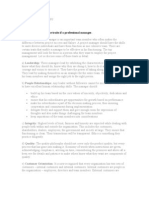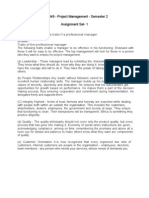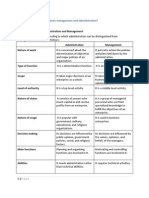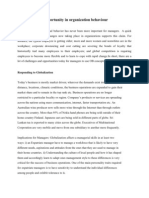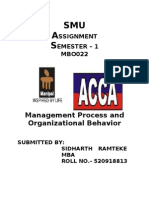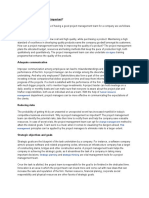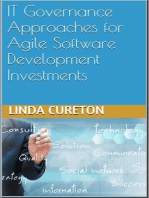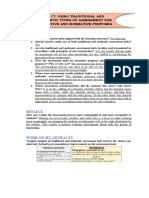Q.1 List and Explain The Traits of A Professional Manager
Q.1 List and Explain The Traits of A Professional Manager
Uploaded by
Dilip Purohit-ErCopyright:
Available Formats
Q.1 List and Explain The Traits of A Professional Manager
Q.1 List and Explain The Traits of A Professional Manager
Uploaded by
Dilip Purohit-ErOriginal Title
Copyright
Available Formats
Share this document
Did you find this document useful?
Is this content inappropriate?
Copyright:
Available Formats
Q.1 List and Explain The Traits of A Professional Manager
Q.1 List and Explain The Traits of A Professional Manager
Uploaded by
Dilip Purohit-ErCopyright:
Available Formats
Q.1 List and explain the traits of a professional manager. A project manager is a person who manages the project.
The project manager is responsible for carrying out all the tasks of a project. Responsibilities of the project manager include: Budgeting and cost control Scheduling tasks Allocating resources Tracking project expenditures Ensuring technical quality Managing relations with the customer and company The project manager is an important team member who often makes the difference between project success and failure. You already learned earlier that the first step of successful Project Management lies in understanding that each project and each team is unique, and should be handled accordingly. A project manager should have the skills to unite diverse individuals and have them function as one cohesive team. It is a wrong notion that a project manager only needs team management skills. In reality, a project manager needs many more skills.
a) Leadership: These managers lead by exhibiting the characteristics of leadership. They know what they should do, know why they are doing it, how to do it and have the courage and vision to execute it. They have the power of taking along others with them. They lead by making themselves as an example for the entire team. He is about to trust his team members and assign the right job to the right person. b) People Relationships: Any leader without followers cannot be successful. They need to have excellent human relationship skills. The manager should: build up his team based on the core values of sincerity, objectivity, dedication and ethics ensure that his subordinates get opportunities for growth based on performance. make his subordinates a part of the decision making process, thus ensuring cooperation and commitment during implementation delegate freely and support them
give enough room for expression of thoughts and also make things challenging for team members keep aspirations of the team members into considerations
c) Integrity: Highest levels of trust, fairness and honesty are expected while dealing with people both within and outside the organisation. This includes the customers, shareholders, dealers, employees, the government and society at large. They ensure that functioning is clean. Their transactions will be transparent. Ethics is something they practice diligently d) Quality: The quality philosophy should not cover only the product quality, but every process that has gone into making it. Economy of words when instructions are given, acknowledging compliance, arriving on time, remembering the promises and above all a keen eye for details and patience to make others know what they want are components of quality. e) Customer Orientation: It is now recognised that every organisation has two sets of customers - internal customers and external customers. Internal customers are people in the organisation employees, directors and team members. External customers are clients and all members of society the company comes in contact in connection with the business. Both the customers need the companys solutions for their problems. So, the managers thinking about any problem is - what can I do for him - and all actions will be in that direction. He should constantly thrive for customer satisfaction. f) Innovation and creativity: Professional managers think beyond the obvious. They exhibit a keenness to go behind a problem and attempt to find the root cause of the problem. They will draw from their experience from diverse fields, seek further information and consider all possible alternatives and come out with some new and unique solution. This happens when they have open minds.
g) Performance Management: The professional manager not only ensures that his performance is at peak all times, but motivates his entire team to perform the same. This comes by appreciation and encouragement. In case of shortfalls, he arranges training for them so that their performance improves. Thus the team members know that they are expected to perform, that they get help to do so and their effort is recognised and rewarded too. This is the simple path of performance management.
Q.2 Describe in brief the various aspects of programme management? Todays economic environment presents many challenges for Business and Information Technology leaders. These challenges require them to consider introduction of significant cost saving, process efficiency, and delivery effectiveness, while managing an increasingly complex portfolio of business projects. This is not an easy job at all unless a proper and portfolio management is in place. In an industry where over 70% of projects have consistently failed to meet business objectives, and where it is often difficult to control project budgets and schedules, effective practices in project, program, and portfolio management are more critical than ever before. Many of the approaches for mitigating the risk associated with this high rate of project failure are not new. However these approaches need to be reintroduced in a disciplined and structured operating process. It is common to apply project management discipline to specific components of the change - particularly the IT systems. Even greater focus and rigour should be applied towards achieving the overall business objective. Organisations need to monitor each project and make a programme to manage them as a group to leverage the advantages and become ready for managing diversity. This is known as Project and Program Management
a) Risk Management: Evaluating and mitigating the risks associated with the programme is very important. This may have impact on the planned changes to the business operations.
b) Process: Process governing the delivery of the project should be well defined. They should ensure that the quality and purposes are fully met. c) Change Management: We saw in earlier chapters that change is a part of any project and hence a programme as well. This deals with keeping a track of the changes and developments external to the project environment and studying their impact on the programme . d) Personnel Management: Human resource is one of the most important resources in programme management. We need to ensure that people are adequately trained and placed at the right place. This is essential to ensure on schedule and smooth delivery of the projects . e) Support Services: We need to ensure that the support services like human resources and IT are able to adapt to the changes that take place in the projects as well as business operations as a whole.
Q.3 Compare the following:
a. Traditional Vs. Projectised Organization b. Reengineering Vs. E-engineering a. Traditional Vs. Projectised Organization Traditional organisations Projectised organisations
They have the formal organisation structure, with departments, functions, sections having a hierarchy of managers and their assistants. All of the managers function on a continuous basis catering to a series of requirements issued by the planning department. An assembly of various units of their production forms a products and a variety of such products make up the business of the company. No particular member or a department or a team is responsible for the completion of any particular product. Their creativity and innovation is in particular respect of their jobs. Most of the members do not get exposed to other areas of operations They have teams comprising members who are responsible for completing one entire deliverable product. The teams will have all the resources required to finish the jobs They have a time schedule within which all the elements of the projects have to be completed. There is greater accountability among team members and everyone is responsible for the delivery.
It is found that a sense of ownership of the project motivates team
in the organisation. They become specialists and insular.
members to be creative, cooperative among them to achieve high productivity.
b. Reengineering Vs. E-engineering Reengineering This is a process by which managers redesign a bundle of tasks into roles and functions so that organisational effectiveness is achieved. By doing so dramatic improvements in critical measures of performance like cost, quality and service are expected. There will be a radical rethink about the business processes adopted. A business process may be of any activity like inventory control, product design, orders processing, and delivery systems. No reference is taken to the existing process and an entirely new process is adopted. The following rules for reengineering are effective: i) Make changes with the outcome in mind not the tasks that result in them. ii) Make the users of the results of the process effect the change. iii) Let the people on the spot decide on the solution decentralise.
E-engineering The term E-Engineering refers to the attempts of companies to make use of all kinds of information systems, to make their functions efficient. New information systems are installed for conducting all business processes in the organisation. The use of electronic communication within the organisation enables frequent interactions between employees and results in better communication. Typically meetings require their presence, but with teleconferencing a lot of time and money is saved. Data have repositories which are accessible, transferable and updatable instantly and used by all concerned. Cross-functional workflows make it easier to coordinate activities. The increase in efficiency makes the organisation meet customers requirements faster. All these result in widespread utilisation of knowledge in the organisation. It helps in creating and making available high quality of information. The information system also comprises of intranet and internet solutions to carry on their regular activities online. Q.4 List out the macro issues in project management and explain each. A. Evolving Key Success Factors (KSF) Upfront: In order to provide complete stability to fulfilment of goals, a project manager needs to constantly evaluate the key success factors from time to time. While doing so, he needs to keep the following aspects of KSFs in mind:
The KSF should be evolved based on a basic consensus document (BCD). KSF will also provide an input to effective exit strategy (EES). Exit here does not mean exit from the project but from any of the drilled down elemental activities which may prove to be hurdles rather than contributors.
Broad level of KSF should be available at the conceptual stage and should be firmed up and detailed out during the planning stage. The easiest way would be for the team to evaluate each step for chances of success on a scale of ten. KSF should be available to the management - duly approved by the project manager - before execution and control stages. KSF rides above normal consideration of time and cost at the levels encompassing client expectation and management perception time and cost come into play as subservient to these major goals.
b. Empowerment Title (ET): ET reflects the relative importance of members of the organisation at three levels: i) Team members are empowered to work within limits of their respective allocated responsibilities. The major change from bureaucratic systems is an expectation from these members to innovate and contribute to time and cost. Group leaders are empowered additionally to act independently towards client expectation and are also vested with some limited financial powers. Managers are empowered further to act independently but to maintain a scientific balance among time, cost, expectation and perception, apart from being a virtual advisor to the top management.
ii) iii)
C .Partnering Decision Making (PDM): PDM is a substitute to monitoring and control. A senior with a better decision making process will work closely with the project managers as well as members to plan what best can be done to manage the future better from past experience. The key here is the active participation of members in the decision making process. The ownership is distributed among all irrespective of levels the term equally should be avoided here since ownership is not quantifiable. The right feeling of ownership is important. This step is most difficult since junior members have to respond and resist being pushed through sheer innovation and performance this is how future leaders would emerge. The PDM process is made scientific through: i) i) ii) iii) Earned value management system (EVMS) Budgeted cost of work scheduled (BCWS) Budgeted cost of work performed (BCWP) Actual cost of work performed (ACWP)
d. Management by Exception (MBE):
No news is good news. If a member wants help he or she locates a source and proposes to the manager only if such help is not accessible for free. Similarly, a member should believe that a team leaders silence is a sign of approval and should not provoke comments through excessive seeking of opinions. In short leave people alone and let situation perform the demanding act. The bend limit of MBE can be evolved depending on the sensitivity of the nature and size of the project. MBE provides and facilitates better implementation of effectiveness of empowerment titles. MBE is more important since organisations are moving toward multi-skilled functioning even at junior most levels.
Q.5 Describe the various steps in risk management listed below: a. Risk Identification Risk identification occurs at each stage of the project life cycle. To identify risks, we must first define risk. As defined earlier, risks are potential problems, ones that are not guaranteed to occur. When people begin performing risk identification they often start by listing known problems. Known problems are not risks. During risk identification, you might notice some known problems. If so, just move them to a problem list and concentrate on future potential problems. As projects evolve through project development so too does the risk profile. Project knowledge and understanding keep growing, hence previously identified risks may change and new risks identified throughout the life of the project. Here we will discuss various tools and techniques available for risk identification. The best and most common methodology for risk identification is done using a brainstorming session. The brainstorm typically takes 15-30 minutes. You have to be sure to invite anyone who can help the team think of risks. Invite the project team, customer, people who have been on similar projects, and experts in the subject area of the project. Involving all stakeholders is very important. Limit the group size to nine people. In the brainstorming session, participants discuss out potential problems that they think could harm the project. New ideas are generated based on the items on the brainstorm list. A project manager can also use the process to refer to a database of risk obtained from past. Here, prior experience and learning from past project plays a very important role. The information obtained from such databases can help the project manager to evaluate and assess the nature of the risk and its impact on the project. Also to a great extent the judgment of the project manager based upon his past experience comes very handy in dealing with risks. Another important method is to generate alternative solution or methodology to deal with risk. Generate solution by means of group review meetings or a brainstorm session. However, consider the following points during a brainstorm session:
Selection of weak areas in a project, such as unknown technology being used or to be used Things those are critical or extremely important to the effort, such as the timely delivery of a vendors database software, creation of translators, or a user interface that meets the customers needs
Things that have caused problems in the past, such as loss of key staff, missed deadlines, or error-prone software Some examples of risks that may be identified in such sessions are: We may not have the requirements right The technology is untested Key people may leave The server wont restart in situation X People might resist the change
b. Risk Analysis The first step in risk analysis is to make each risk item more specific. Risks such as, Lack of management buy-in, and people might leave, are a little ambiguous. In these cases the group might decide to split the risk into smaller specific risks, such as, manager decides that the project is not beneficial, Database expert might leave, and Webmaster might get pulled off the project. The next step is to set priorities and determine where to focus risk mitigation efforts. Some of the identified risks are unlikely to occur, and others might not be serious enough to worry about. Paretos law studied earlier applies here. During the analysis, discuss with the team members each risk item to understand how devastating it would be if it did occur, and how likely it is to occur. This way you can gauge the probability of occurrence and the impact created.
Sensitivity Analysis: In sensitivity analysis, a study is done to analyse the changes in the variable values because of a change in one or more of the decision criteria. Probabilistic Analysis: In the probability analysis, the frequency of a particular event occurring is determined, based on which its average weighted average value is calculated. Each outcome of an event resulting in a risk situation in a risk analysis process is expressed as a probability. Risk analysis can be performed by calculating the expected value of each alternative and selecting the best alternative. Now that the group has assigned a priority to each risk, it is ready to select the items to manage. Some projects select a subset to take action upon, while others choose to work on all of the items. c. Risk Management Planning After analysing and prioritising, the focus comes on management of the identified risks. In order to maximise the benefits of project risk management, you must incorporate the project risk management activities into our project management plan and work activities. There are two things you can do to manage risk. The first is to take action to reduce (or partially reduce) the likelihood of the risk occurring. For example, some project that work on process improvement make their deadlines earlier and increases their efforts to minimise the likelihood of team members being pulled off the project due to changing organisational priorities. In a software product, a critical feature might be developed first and tested early. Second, you can take action to reduce the impact if the risk does occur. Sometimes this is an action taken prior to the crisis, such as the creation of a simulator to use for testing if the hardware is late. At other times, it is a simple backup plan, such as running a night shift to share hardware. For the potential loss of a key person, for example, you might do two things. You may plan to reduce the impact by making sure other people become familiar with that persons work, or reduce the likelihood of attrition by giving the person a raise, or by providing extra benefits. d. Risk Review After you have implemented response actions, you must track and record their effectiveness and any changes to the project risk profile. You need to review the risks periodically so that you can check how well mitigation is progressing. You can also see if the risk priorities need to change, or if new risks have been discovered. In such case, you might decide to rerun the complete risk process if significant changes have occurred on the project. Significant changes might include the addition of new features, the changing of the target platform, or a change in project team members. Many people incorporate risk review into
other regularly scheduled project reviews. In summary, risk management is the planning to potential problems, and the management of actions taken related to those problems.
Q.6 ABC Company implements got a very big project and they decided to allot the same to a new project manager, who joined the company recently. In order to execute the project successfully, what are the various phases in which the project lifecycle should be divided.
You might also like
- Module 1 Principles of Construction ManagementDocument47 pagesModule 1 Principles of Construction ManagementRed Torio100% (2)
- DBB 1204 Set 1 and 2Document5 pagesDBB 1204 Set 1 and 2Anchu NainaNo ratings yet
- MKSAP 17 Audio Companion 2015 - PDF File - Cardiology PDFDocument68 pagesMKSAP 17 Audio Companion 2015 - PDF File - Cardiology PDFPaul StatoNo ratings yet
- (Problem solving in mathematics and beyond 7) Geretschläger, Robert_ Kalinowski, Józef_ Švrček, Jaroslav - A Central European Olympiad_ The mathematical duel-World Scientific Publishing Co. Pte. Ltd (.pdfDocument289 pages(Problem solving in mathematics and beyond 7) Geretschläger, Robert_ Kalinowski, Józef_ Švrček, Jaroslav - A Central European Olympiad_ The mathematical duel-World Scientific Publishing Co. Pte. Ltd (.pdfAlex100% (2)
- List and Explain The Traits If A Professional ManagerDocument10 pagesList and Explain The Traits If A Professional ManagerAmitabh ChatterjeeNo ratings yet
- Assignment On Project Management (MB0049) : Submitted byDocument9 pagesAssignment On Project Management (MB0049) : Submitted byHitesh BalujaNo ratings yet
- Project Management - MB0049: Q.1 List and Explain The Traits If A Professional ManagerDocument5 pagesProject Management - MB0049: Q.1 List and Explain The Traits If A Professional ManagergurugabruNo ratings yet
- Project Management - MB0049 - 4 Credits: Master of Business Administration-MBA Semester 2Document10 pagesProject Management - MB0049 - 4 Credits: Master of Business Administration-MBA Semester 2Jyothi RaoNo ratings yet
- MB0049-Fall Drive-Assignment-2011 - Set 1 & 2Document29 pagesMB0049-Fall Drive-Assignment-2011 - Set 1 & 2dineshhegdekhNo ratings yet
- What Is The Difference Between Management and AdministrationDocument16 pagesWhat Is The Difference Between Management and AdministrationMaisha Tabassum100% (3)
- Prerequisites For Lean Implementation of An OrganizationDocument2 pagesPrerequisites For Lean Implementation of An OrganizationDineeka HimashiNo ratings yet
- Frede Lee E. FloresDocument4 pagesFrede Lee E. FloresJovito Dela TorreNo ratings yet
- mb0049 Set 1 Set 2 Winterfall 2010 NoveDocument6 pagesmb0049 Set 1 Set 2 Winterfall 2010 NoveVinay SaxenaNo ratings yet
- Why Do You Say That Project Management Is The Best Method of Implementing ChangeDocument10 pagesWhy Do You Say That Project Management Is The Best Method of Implementing ChangeFaisal HameedNo ratings yet
- Task 1Document21 pagesTask 1StoffNo ratings yet
- 1.6challenges and Opportunity For Organization Behaviour 1Document13 pages1.6challenges and Opportunity For Organization Behaviour 1Balakrishna Nalawade N0% (1)
- Program: Master of Business Administration - MBA Semester: II (FALL 2010) Subject Code: MB0049 Subject Name: Project Management Assignment: Set - 2Document12 pagesProgram: Master of Business Administration - MBA Semester: II (FALL 2010) Subject Code: MB0049 Subject Name: Project Management Assignment: Set - 2apex01No ratings yet
- Improving Project Management Through Best Practices & Change ManagementDocument4 pagesImproving Project Management Through Best Practices & Change ManagementxonstanceNo ratings yet
- PM Solutions-1Document3 pagesPM Solutions-1shreyasdcdraitNo ratings yet
- BPMDocument27 pagesBPMDevesh GandhiNo ratings yet
- Project Management and Change Management MethodologyDocument6 pagesProject Management and Change Management MethodologyThandabantu MagengeleleNo ratings yet
- Introduction To Software Project ManagementDocument38 pagesIntroduction To Software Project ManagementAman guptaNo ratings yet
- QMR PDFDocument58 pagesQMR PDFKhadeer Ahamed100% (1)
- 14 Common Pitfalls of Business Process ReengineeringDocument11 pages14 Common Pitfalls of Business Process ReengineeringPrasanth ViswanathanNo ratings yet
- Assign Facilitate Cont. ImprovementDocument17 pagesAssign Facilitate Cont. ImprovementUpkar S100% (5)
- Management Process and Organizational Behavior CompleteDocument18 pagesManagement Process and Organizational Behavior CompleteR. Sidharth33% (3)
- CE PROF 1 Workshop Group 1 1Document19 pagesCE PROF 1 Workshop Group 1 1Keint SodeNo ratings yet
- S - PM NoteDocument53 pagesS - PM NoteNhư Quỳnh NguyễnNo ratings yet
- Aasif AssignmentDocument3 pagesAasif AssignmentattaurrehmanNo ratings yet
- Managing The Change ProcessDocument12 pagesManaging The Change ProcessSmart WriterNo ratings yet
- CHAPTER FOURDocument26 pagesCHAPTER FOURaxmedmuumin86No ratings yet
- Challenges and Opportunities For OB: 1. Improving People Skills: Technological Changes, Structural ChangesDocument9 pagesChallenges and Opportunities For OB: 1. Improving People Skills: Technological Changes, Structural ChangesButch kevin adovasNo ratings yet
- 7 Organization Issues in Project ManagementDocument11 pages7 Organization Issues in Project ManagementPriya GangwarNo ratings yet
- Lesson 1 - Operation Managment - Sir HenryDocument22 pagesLesson 1 - Operation Managment - Sir HenryPatrizia Nicole GozeNo ratings yet
- Written Report 3Document15 pagesWritten Report 3John BenedickNo ratings yet
- ITPM Unit 1Document28 pagesITPM Unit 1venkadesh.p.2021.csbsNo ratings yet
- ODDocument18 pagesODMeenakshi GodaraNo ratings yet
- Fedhi Review ArticleDocument12 pagesFedhi Review ArticleBonat Fininsa DhabaNo ratings yet
- Change ManagementDocument17 pagesChange ManagementJeromeNo ratings yet
- Don't Manage Your Project. Lead Your Project!: Ten Steps To Project LeadershipDocument4 pagesDon't Manage Your Project. Lead Your Project!: Ten Steps To Project LeadershipDexterNo ratings yet
- Lecture 2 - Management Styles and Responsibilities - v1Document37 pagesLecture 2 - Management Styles and Responsibilities - v1Obonolo Benn0% (1)
- Role of HR in Project ManagementDocument11 pagesRole of HR in Project ManagementHarshada ChavanNo ratings yet
- Important - Read This First: PlagiarismDocument13 pagesImportant - Read This First: PlagiarismMonique Marcolin BugeNo ratings yet
- Project Management - Notes-1Document6 pagesProject Management - Notes-1Maximillan LobuinNo ratings yet
- Review Questions PMDocument40 pagesReview Questions PMPhương Chi VũNo ratings yet
- Why Is Project Management Important?: Six SigmaDocument4 pagesWhy Is Project Management Important?: Six SigmaSam VillaganasNo ratings yet
- Total Quality ManagementDocument7 pagesTotal Quality ManagementRose Anne PalenciaNo ratings yet
- 1695_3334_1_CSC-4102_lecture 5Document43 pages1695_3334_1_CSC-4102_lecture 5Tahzeeb SayedNo ratings yet
- PM Unit 1 Q & ADocument17 pagesPM Unit 1 Q & APriya Guna100% (1)
- Pom Mini ProjectDocument7 pagesPom Mini ProjectKHUSHI VARENYANo ratings yet
- Chapter 1 - "Know Where You Are"Document29 pagesChapter 1 - "Know Where You Are"Gj RilloNo ratings yet
- Key Tricks-SampleDocument39 pagesKey Tricks-SampleMehrdad MahdavianNo ratings yet
- Revisions OnlyDocument16 pagesRevisions OnlyKafonyi JohnNo ratings yet
- IT GOVERNANCE APPROACHES FOR AGILE SOFTWARE DEVELOPMENT INVESTMENTSFrom EverandIT GOVERNANCE APPROACHES FOR AGILE SOFTWARE DEVELOPMENT INVESTMENTSRating: 4 out of 5 stars4/5 (1)
- Challenges of Management in OBDocument7 pagesChallenges of Management in OBvedkuvarba rathodNo ratings yet
- Project Management - Notes-2Document17 pagesProject Management - Notes-2Maximillan LobuinNo ratings yet
- Chapter 1 OCDDocument16 pagesChapter 1 OCDMr. Srikanth KNo ratings yet
- PM Interview Q&SDocument16 pagesPM Interview Q&SNarendra BabuNo ratings yet
- Process Planning - Vers 1.0Document6 pagesProcess Planning - Vers 1.0arun_alexNo ratings yet
- Project ManagementDocument7 pagesProject ManagementCLARISSA MARIE PAGADDU DE MATANo ratings yet
- Lessons For An Accidental ProfessionDocument11 pagesLessons For An Accidental Professionfriskiee100% (1)
- Project Management For Beginners: The ultimate beginners guide to fast & effective project management!From EverandProject Management For Beginners: The ultimate beginners guide to fast & effective project management!Rating: 4 out of 5 stars4/5 (1)
- IAO's Accreditation For School.Document20 pagesIAO's Accreditation For School.International Accreditation OrganizationNo ratings yet
- Edgar Dale's Cone of ExperienceDocument53 pagesEdgar Dale's Cone of ExperienceBart VillanuevaNo ratings yet
- HSE InterviewDocument12 pagesHSE InterviewMuhammad Aftab Ahmed100% (3)
- Chapter 5 Trends and Issues in Teaching Gifted and Talented LearnersDocument11 pagesChapter 5 Trends and Issues in Teaching Gifted and Talented LearnersRianicole DechavezNo ratings yet
- Lesson Plan Curriculum IntegrationDocument12 pagesLesson Plan Curriculum Integrationapi-509185462No ratings yet
- Concept PaperDocument4 pagesConcept PaperCri-santo AbellaNo ratings yet
- Coursera UEELUHJSTCBL - Financial Accounting - FoundationDocument1 pageCoursera UEELUHJSTCBL - Financial Accounting - FoundationUlayya SarfinaNo ratings yet
- The Effectiveness of Guided Inquiry-Based Learning To Train Critical Thinking Skills in High School LevelDocument3 pagesThe Effectiveness of Guided Inquiry-Based Learning To Train Critical Thinking Skills in High School Levelnafi hakimNo ratings yet
- 2022 Pines Academy 2Document20 pages2022 Pines Academy 2PHAM THI TAMNo ratings yet
- University of Rizal SystemDocument3 pagesUniversity of Rizal SystemJhonric M. LugtuNo ratings yet
- Medical Affairs Ophthalmology Consultant in Orange County CA Resume Ana Mercedes TribinDocument8 pagesMedical Affairs Ophthalmology Consultant in Orange County CA Resume Ana Mercedes TribinAnaMercedesTribinNo ratings yet
- SET 3 VE Majorship DrillsDocument7 pagesSET 3 VE Majorship DrillsDarren Christian Ray LangitNo ratings yet
- Doyle - Review of Jeremy Munday - Style and Ideology in TranslationDocument8 pagesDoyle - Review of Jeremy Munday - Style and Ideology in Translationyudi909No ratings yet
- If You Were My Homework I Would Do You On The TableDocument6 pagesIf You Were My Homework I Would Do You On The Tableafnoebhcdeypyp100% (1)
- AUDIT - Information Audit Theory Vs PracticeDocument11 pagesAUDIT - Information Audit Theory Vs PracticeMichael WakariNo ratings yet
- Application For Language Awareness DLP - As Per 25 February 2022Document4 pagesApplication For Language Awareness DLP - As Per 25 February 2022SK BATU LANCHANG-CM8 MoeNo ratings yet
- Rentz MCI Public Forum TalkDocument27 pagesRentz MCI Public Forum TalkWorldEventsForumNo ratings yet
- Lesson 12 The Fisherman and The FishDocument3 pagesLesson 12 The Fisherman and The FishSamatNo ratings yet
- At The End of The Discussion, Students Are Expected To: Learning ActivitiesDocument3 pagesAt The End of The Discussion, Students Are Expected To: Learning ActivitiesMara LabanderoNo ratings yet
- 2d Lesson Plan - Nature CollageDocument2 pages2d Lesson Plan - Nature Collageapi-630719553No ratings yet
- Iraq ISCDocument80 pagesIraq ISCcorderocoleen8No ratings yet
- 464 - Emt 405 NoteDocument43 pages464 - Emt 405 NoteManfred GithinjiNo ratings yet
- (Handicraft Making) Quarter 1: Learner'S MaterialDocument25 pages(Handicraft Making) Quarter 1: Learner'S MaterialJenusse Rian L. AdolfoNo ratings yet
- IMG Orientation Power Point v1.4Document102 pagesIMG Orientation Power Point v1.4Jora IonNo ratings yet
- Grade 7-8Document150 pagesGrade 7-8Abhishek SainiNo ratings yet
- Semester 1 - BPT1501 Assignment 6 Lesson 5 (01.02.2024)Document5 pagesSemester 1 - BPT1501 Assignment 6 Lesson 5 (01.02.2024)mbikoasive39No ratings yet
- FS2 Le17Document2 pagesFS2 Le17Jorebell W. QuiminoNo ratings yet
- Ed 304 The Teacher and The Community, School Culture & Organizational Leadership ModuleDocument16 pagesEd 304 The Teacher and The Community, School Culture & Organizational Leadership ModuleAljun Emperado100% (3)




